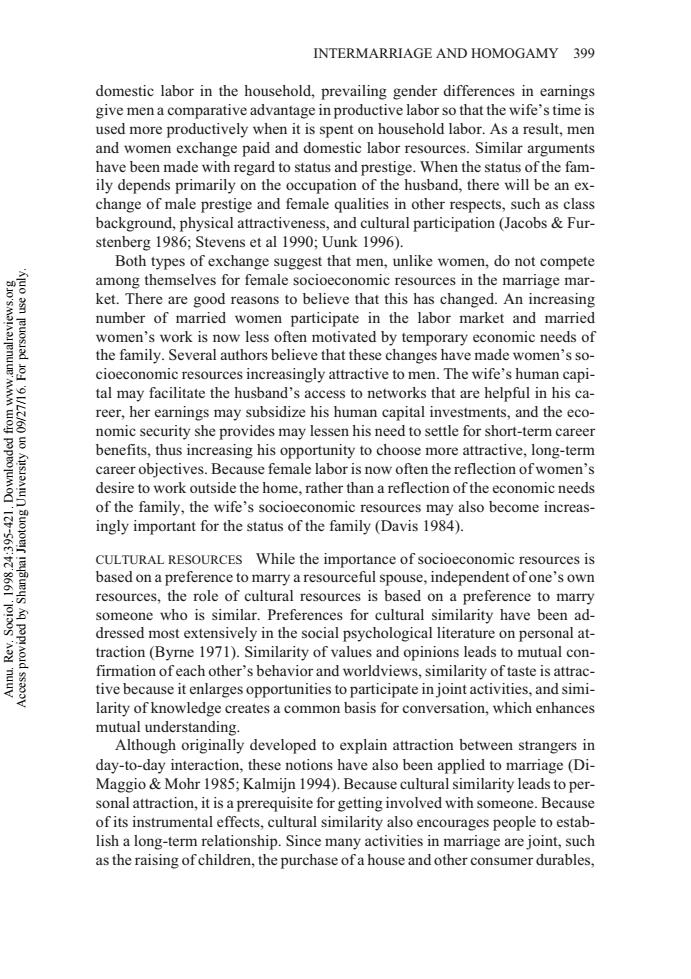正在加载图片...

INTERMARRIAGE AND HOMOGAMY 399 domestic labor in the household,prevailing gender differences in earnings give men a comparative advantage in productive labor so that the wife's time is used more productively when it is spent on household labor.As a result,men and women exchange paid and domestic labor resources.Similar arguments have been made with regard to status and prestige.When the status of the fam- ily depends primarily on the occupation of the husband,there will be an ex- change of male prestige and female qualities in other respects,such as class background,physical attractiveness,and cultural participation (Jacobs Fur- stenberg 1986;Stevens et al 1990;Uunk 1996). Both types of exchange suggest that men,unlike women,do not compete among themselves for female socioeconomic resources in the marriage mar- ket.There are good reasons to believe that this has changed.An increasing number of married women participate in the labor market and married women's work is now less often motivated by temporary economic needs of 0'SMOIAIenu MA wo popeojuMod'I-S6E:8661 o1oS the family.Several authors believe that these changes have made women's so- cioeconomic resources increasingly attractive to men.The wife's human capi- 9922/60 tal may facilitate the husband's access to networks that are helpful in his ca- reer,her earnings may subsidize his human capital investments,and the eco- nomic security she provides may lessen his need to settle for short-term career benefits,thus increasing his opportunity to choose more attractive,long-term career objectives.Because female labor is now often the reflection of women's desire to work outside the home,rather than a reflection of the economic needs of the family,the wife's socioeconomic resources may also become increas- ingly important for the status of the family (Davis 1984). CULTURAL RESOURCES While the importance of socioeconomic resources is reyaueys q pop based on a preference to marry a resourceful spouse,independent of one's own resources,the role of cultural resources is based on a preference to marry someone who is similar.Preferences for cultural similarity have been ad- 2 dressed most extensively in the social psychological literature on personal at- traction(Byrne 1971).Similarity of values and opinions leads to mutual con- 具量 firmation ofeach other's behavior and worldviews,similarity of taste is attrac- tive because it enlarges opportunities to participate in joint activities,and simi- larity of knowledge creates a common basis for conversation,which enhances mutual understanding. Although originally developed to explain attraction between strangers in day-to-day interaction,these notions have also been applied to marriage(Di- Maggio Mohr 1985;Kalmijn 1994).Because cultural similarity leads to per- sonal attraction,it is a prerequisite for getting involved with someone.Because of its instrumental effects,cultural similarity also encourages people to estab- lish a long-term relationship.Since many activities in marriage are joint,such as the raising of children,the purchase of a house and other consumer durables,domestic labor in the household, prevailing gender differences in earnings give men a comparative advantage in productive labor so that the wife’s time is used more productively when it is spent on household labor. As a result, men and women exchange paid and domestic labor resources. Similar arguments have been made with regard to status and prestige. When the status of the family depends primarily on the occupation of the husband, there will be an exchange of male prestige and female qualities in other respects, such as class background, physical attractiveness, and cultural participation (Jacobs & Furstenberg 1986; Stevens et al 1990; Uunk 1996). Both types of exchange suggest that men, unlike women, do not compete among themselves for female socioeconomic resources in the marriage market. There are good reasons to believe that this has changed. An increasing number of married women participate in the labor market and married women’s work is now less often motivated by temporary economic needs of the family. Several authors believe that these changes have made women’s socioeconomic resources increasingly attractive to men. The wife’s human capital may facilitate the husband’s access to networks that are helpful in his career, her earnings may subsidize his human capital investments, and the economic security she provides may lessen his need to settle for short-term career benefits, thus increasing his opportunity to choose more attractive, long-term career objectives. Because female labor is now often the reflection of women’s desire to work outside the home, rather than a reflection of the economic needs of the family, the wife’s socioeconomic resources may also become increasingly important for the status of the family (Davis 1984). CULTURAL RESOURCES While the importance of socioeconomic resources is based on a preference to marry a resourceful spouse, independent of one’s own resources, the role of cultural resources is based on a preference to marry someone who is similar. Preferences for cultural similarity have been addressed most extensively in the social psychological literature on personal attraction (Byrne 1971). Similarity of values and opinions leads to mutual confirmation of each other’s behavior and worldviews, similarity of taste is attractive because it enlarges opportunities to participate in joint activities, and similarity of knowledge creates a common basis for conversation, which enhances mutual understanding. Although originally developed to explain attraction between strangers in day-to-day interaction, these notions have also been applied to marriage (DiMaggio & Mohr 1985; Kalmijn 1994). Because cultural similarity leads to personal attraction, it is a prerequisite for getting involved with someone. Because of its instrumental effects, cultural similarity also encourages people to establish a long-term relationship. Since many activities in marriage are joint, such as the raising of children, the purchase of a house and other consumer durables, INTERMARRIAGE AND HOMOGAMY 399 Annu. Rev. Sociol. 1998.24:395-421. Downloaded from www.annualreviews.org Access provided by Shanghai Jiaotong University on 09/27/16. For personal use only